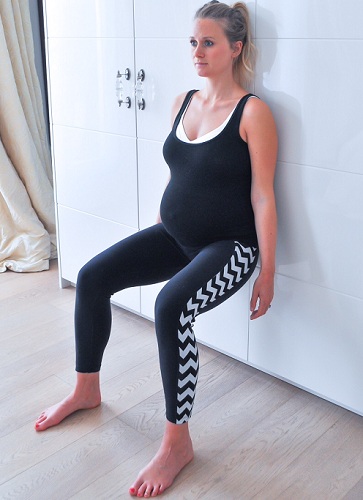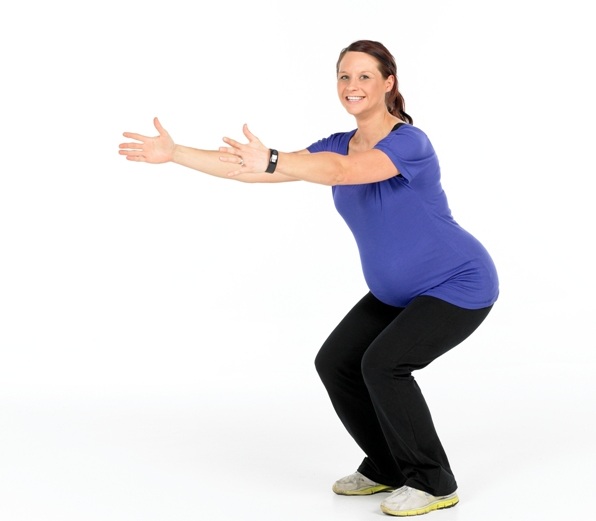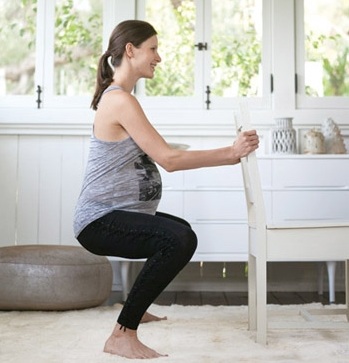Exercising properly will always have a positive effect on one’s health and mental well-being. This fact remains true when one is pregnant though certain precautions should be taken so as to pose no potential harm to your unborn child. Squats are generally considered safe at all stages of pregnancy though you should speak with a health care professional before performing any exercises when you are carrying a child.
Should I Do Squats During Pregnancy?
Squatting is a great exercise that works large muscle groups and is effective in getting one’s heart pumping. To do this exercise when being pregnant, all you need is a sturdy table or chair for leverage and a bit of free time. Since every expecting mother has unique health condition, here are the benefits and risks of doing squats so that you can decide whether to do it or not.
Health Benefits of Squats During Pregnancy
- Increase the Strength of Pelvic Floor Muscles
Before you give birth to your child, it would be wise to strengthen your pelvic floor muscles and get them ready for the big day. The strengthening of these muscles can increase the ease of your labor.
- Prevent Lower Back and Pelvic Pain
During pregnancy, you are likely to feel pain in numerous places as your baby grows inside you. Squats will help to build up your gluteus, your quadriceps and other leg muscles, offering more support to your pelvic region and reducing pain.
- Prepare You for Delivery
Squatting help to prepare you for the birth of your child in numerous ways. The position when you do a squat can be utilized during labor to help with the pain. The exercise can also aid the baby to move lower into the pelvis.
- Give You Endurance in Birthing Positions
Building up strength in the right places via performing squats can give you endurance for the day when your baby arrives. The squat position can also be helpful in allowing the pelvic area to open.
Potential Risks of Squats During Pregnancy
- Loss of Balance
You may lose your balance during the exercise and fall over. Therefore, it is wise to use a strong table or chair to grip onto to help you maintain balance.
- Knee Injuries
The exercise may also lead to an injury to your knees. The ligaments within your knees may stretch or tear, especially if they are overworked or exposed to too much pressure.
When Should You Avoid Squatting?
- When Your Baby Is in Breech Position
You should avoid squats if your baby’s feet or bottom are facing downward towards the ground. Squatting may make your breech baby descend deeper into the pelvic area and make it more difficult to turn. Wait until you feel your child turn to the headfirst position before squatting.
- You Feel Pain When Squatting
If you feel pain during squatting, you should discontinue immediately. There will likely be some challenge to the exercise, but any pain greater than the expected discomfort means that you may be practicing a poor technique or have overworked your body.
- You Are in Certain Medical Conditions
If you have certain medical conditions such as vasa previa, squats during pregnancy may be a bad idea and may even lead to early labor. Always speak with your health care professional or midwife before doing this exercise.
Safe Squatting Exercises During Pregnancy
1. Sumo Squat
 If you have ever seen a sumo wrestler, you can imagine what this squat entails. First, stand up straight with your chest up. Next, turn your feet outward at a 45 degree angle. Place your arms straight out in front of you. You can also use a dumbbell if you wish. Bend your knees and begin to descend, ensuring to keep your knees in front of your ankles when you bend down. Aim to do this exercise around fifteen times, rest and do another set (if you feel up to it).
If you have ever seen a sumo wrestler, you can imagine what this squat entails. First, stand up straight with your chest up. Next, turn your feet outward at a 45 degree angle. Place your arms straight out in front of you. You can also use a dumbbell if you wish. Bend your knees and begin to descend, ensuring to keep your knees in front of your ankles when you bend down. Aim to do this exercise around fifteen times, rest and do another set (if you feel up to it).
2. Wall Squat Sliding Down
 This exercise requires the help of pillows. Simply put a few pillows near a wall for you to land on. Lean your back against the wall with your feet facing forward, shoulder width apart. Make sure your back is straight and gradually bend your knees as though you were sitting down. Place your hands on your knees to assist you with your balance as you gently slide down in the direction of the pillows.
This exercise requires the help of pillows. Simply put a few pillows near a wall for you to land on. Lean your back against the wall with your feet facing forward, shoulder width apart. Make sure your back is straight and gradually bend your knees as though you were sitting down. Place your hands on your knees to assist you with your balance as you gently slide down in the direction of the pillows.
3. Simple Squat
 With your feet shoulder width apart and facing slightly outward (to assist your balance), place your palms together and hold them in front of your heart. Inhale deeply and then slowly descend as you exhale. Move your hands to your outstretching knees and descend as far as you feel comfortable. Hold the position and breathe deeply.
With your feet shoulder width apart and facing slightly outward (to assist your balance), place your palms together and hold them in front of your heart. Inhale deeply and then slowly descend as you exhale. Move your hands to your outstretching knees and descend as far as you feel comfortable. Hold the position and breathe deeply.
4. Half Squat with Chair
 Grab a sturdy chair and place it in front of you with the back of the chair close to your body. Keep your feet shoulder width apart and your legs slightly bent. Hold onto the chair for support. Contract our abdomen and hold your chest high. Slowly descend towards the ground as though you were sitting down. Do a couple of sets of around ten repetitions at first. You can then increase the duration or amount of repetitions when you get used to the exercise.
Grab a sturdy chair and place it in front of you with the back of the chair close to your body. Keep your feet shoulder width apart and your legs slightly bent. Hold onto the chair for support. Contract our abdomen and hold your chest high. Slowly descend towards the ground as though you were sitting down. Do a couple of sets of around ten repetitions at first. You can then increase the duration or amount of repetitions when you get used to the exercise.
Watch a video demonstration of squats during pregnancy to learn more.
Other Recommended Exercises for Pregnancy
Except doing squats during pregnancy, you can also try some other forms of exercises when you are pregnant.
1. Aerobic Exercise
Aerobic exercises such as aquanatal classes, swimming and brisk walking are considered generally safe for expectant mothers.
2. Yoga & Pilates
Specialized pre-natal classes of yoga and pilates may make you more relaxed and get you better prepared for your labor.
3. Lifestyle Changes
You don’t even have to spare some time specifically for exercise. Simply change your sedentary lifestyle to a more active one. Instead of using an elevator, use the stairs. Walk to work as opposed to driving.
Note
Always speak with a health care professional before beginning any new exercise regime when being pregnant. If you weren’t active before you got pregnant and you want to start exercising now, start slow and gradually build your endurance. It is of vital importance that you do not try too much too soon. Avoid vigorous exercise like football, basketball, horse riding, mountain climbing and skiing. HERE are more exercises recommended for pregnant women.
